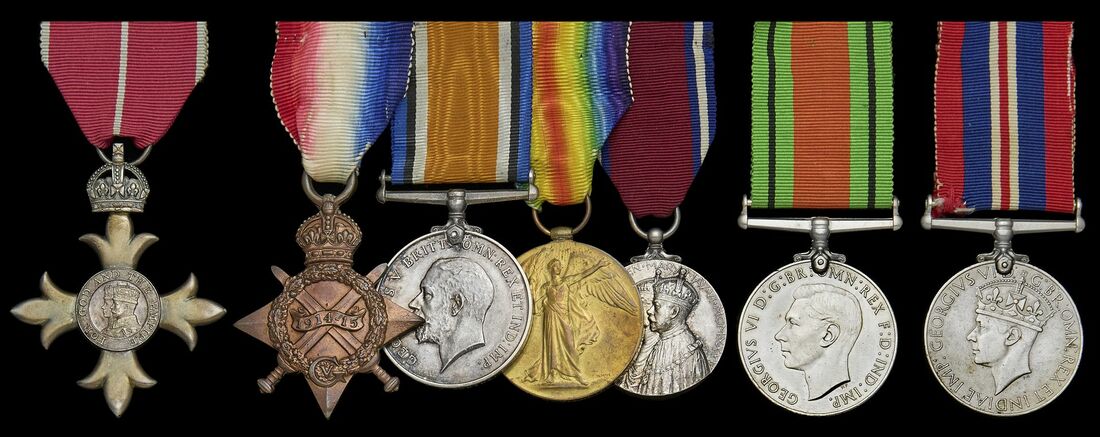
Auction: 24001 - Orders, Decorations and Medals
Lot: 122
A Second World War M.B.E. group of seven awarded to Lieutenant-Commander (Engineer) W. J. Robins, Royal Naval Volunteer Reserve
The Most Excellent Order of the British Empire, Member's (M.B.E.) breast Badge, Military Division, silver; 1914-15 Star (M.1654. W. J. Robins, E.R.A.3, R.N.); British War and Victory Medals (Art. Eng. W. J. Robins, R.N.); Jubilee 1935; Defence and War Medals 1939-45, light contact wear overall, very fine> (7)
M.B.E. London Gazette 1 January 1946.
William James Robins was born at Keyham, Devon on 17 February 1889 and worked as a Fitter prior to enlisting with the Royal Navy as Engine Room Artificer Class IV on 17 February 1910. He was serving ashore with Blake by the outbreak of the Great War, being at some point posted to Nemasis. Joining the Company of the destroyer Magic on 15 February 1917, from there he was appointed Mate (Engineer) on 7 May 1917. Posted to Cruiser on 11 November 1918 as Artificer Engineer, he was to finish the war with her.
Advanced to Commissioned Engineer in 1927 Robins was commissioned Lieutenant (Engineer) on 29 June 1932. After continued good service he placed on the retired list due to age on 17 February 1939. This was not to last for long however as the outbreak of the Second World War saw him return to service on 15 March 1939 as Lieutenant (retired).
Advanced Lieutenant Commander (retired) while still ashore on 20 March 1941 Robins received his first command, the depot ship Dunluce Castle on 18 April. This steamer had served as a Hospital Ship during the Great War but had been sold for breaking in 1939. Fortunately she was saved from the breakers yard by the needs of war however her venerable age left her slow and cumbersome. Early in his time with Dunluce Castle Robins was peripherally involved in the unusual case of the H.M.S. Nestor Mutiny. He was the jailor for the ship's Captain and First Lieutenant, A Naval Career by George Crogiley, refers:
'I was rung up by the Admiralty and told to join H.M.S. Nestor at Scapa Flow forthwith. I packed my kit and got a train going to Thurso. After a long and tedious journey, I eventually arrived and got a boat to Scapa Flow. By this time I had discovered that the Nestor was, in fact, an Australian destroyer.
When I arrived onboard I was met by a fair-haired Lieutenant. I asked if I could see the Captain and he replied that unfortunately, the Captain was under close arrest in H.M.S. Dunluce Castle. I then asked to see the First Lieutenant, to which he replied that he also was under close arrest. I then asked what on earth was going on in this ship.
He explained that both the Captain and First Lieutenant were in the habit of drinking to excess until finally when ordered to sea, the Ship’s Company refused to move. In other words, there had been a kind of mutiny.'
Aside from being a makeshift prison, Dunluce Castle performed numerous tasks first on the Humber and later at Scapa Flow. She was a mail sorting ship, submarine depot and accommodation ship for the anti-submarine and ballon ships that guarded Scapa Flow. Robins' command of her was exemplary and as stated thusly in his service record:
'An exceedingly efficient & capable E.O. The fact that though in shipbreakers hands in 1939 he has maintained the machinery of the ship since 1940 so efficiently that after 5 years at a Buoy she steamed 230 miles at some 9 knots is the best testimonial to his work. A most agreeable messmate.'
Robins was released from service again on 3 September 1945 and returned to the retired list the next day. He was honoured after the war for his contributions both ashore and afloat; sold together with the with the original document of issue as well as copied research including a baptismal register, London Gazette extracts, service papers and a blog post relating to Dunluce Castle.
Subject to 20% VAT on Buyer’s Premium. For more information please view Terms and Conditions for Buyers.
Sold for
£350
Starting price
£350




